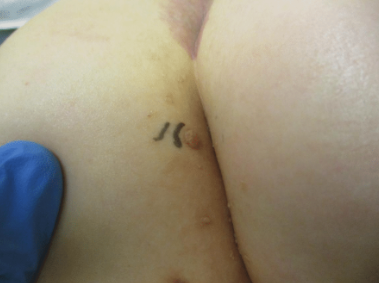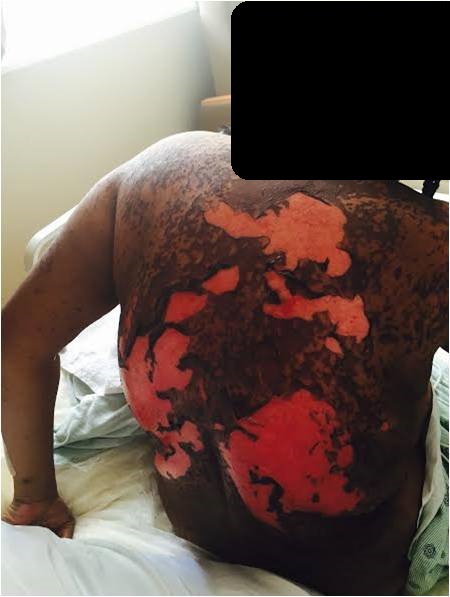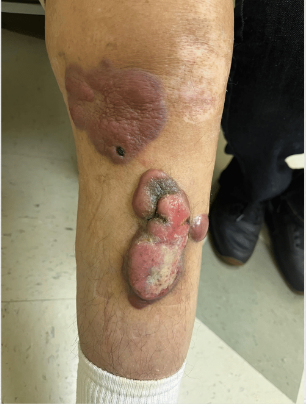CORRECT DIAGNOSIS:
Lymphangioma
DISCUSSION:
Klippel-Trenaunay Syndrome (KTS) is a rare congenital vascular disorder characterized by a triad of features: capillary malformations, venous malformations, and lymphatic malformations, including lymphangiomas. This syndrome often presents with significant limb asymmetry due to hypertrophy, leading to various complications, such as pain, functional impairment, and psychosocial challenges. Understanding the role of lymphangiomas within the context of KTS is crucial for effective management and patient care.
Lymphangiomas are benign tumors that arise from malformations of the lymphatic system. In patients with KTS, these lesions can manifest as soft, fluid-filled swellings, often located in areas affected by other vascular anomalies. Their appearance may vary from cystic to more solid forms, and they are typically painless. The presence of lymphangiomas can exacerbate the limb hypertrophy and other vascular abnormalities associated with KTS, contributing to the complexity of the condition.
Diagnosis of lymphangiomas in KTS is primarily clinical, often supported by imaging techniques such as ultrasound. Ultrasound can reveal the characteristic cystic spaces filled with lymphatic fluid, aiding in distinguishing lymphangiomas from other vascular malformations. Histopathological examination of biopsy samples typically shows dilated lymphatic spaces lined by endothelial cells, surrounded by a fibrous stroma. These diagnostic tools help confirm the presence of lymphangiomas and guide subsequent management decisions.
Management strategies for lymphangiomas in patients with KTS depend on the size, location, and symptoms associated with the lesions. In many cases, observation is appropriate for asymptomatic lymphangiomas that do not impact the patient’s quality of life. However, if the lesions cause discomfort, functional impairment, or significant cosmetic concerns, intervention may be necessary. Sclerotherapy is a minimally invasive option that involves injecting a sclerosing agent into the lymphangioma to reduce its size and improve symptoms. Surgical excision may also be indicated in cases where lymphangiomas are large or causing complications.
The prognosis for lymphangiomas in KTS varies, as these benign lesions can still lead to significant issues in affected individuals. Regular monitoring is essential to assess changes in size or potential complications, ensuring that interventions are timely and appropriate. A multidisciplinary approach involving dermatology, surgery, and vascular specialists is often necessary to provide comprehensive care for patients with KTS and lymphangiomas.
TREATMENT:
Treatment options for lymphangiomas in KTS depend on lesion size, symptoms, and their impact on quality of life. For asymptomatic lymphangiomas, a watchful waiting approach is often appropriate. Many lesions can regress spontaneously, especially in children, making regular monitoring essential. When lymphangiomas become symptomatic, sclerotherapy is a common intervention. This minimally invasive procedure involves injecting a sclerosing agent, such as doxycycline, into the lesion to reduce its size by inducing localized inflammation and fibrosis. Surgical excision may be necessary for larger or symptomatic lymphangiomas, offering definitive treatment and improved cosmetic appearance. In some cases, laser therapy can be employed to enhance aesthetics, particularly for superficial lesions.
Management of lymphangiomas in KTS requires a multidisciplinary approach, involving coordination among dermatologists, vascular surgeons, and pediatricians to address potential complications. Regular follow-up is critical to monitor for changes and ensure comprehensive care.
CONCLUSION:
Lymphangiomas are a significant aspect of Klippel-Trenaunay Syndrome, contributing to the clinical complexity of this rare vascular disorder. Understanding the interplay between lymphatic malformations and other vascular components of KTS is essential for effective management. Options for treatment such as observation, sclerotherapy, surgical excision, and laser therapy can be effectively employed to manage these benign lymphatic malformations. Regular follow-up and a multidisciplinary approach are key to enhancing the quality of life and overall health outcomes for these patients.
REFERENCES:
Karseladze, A., & Sargsyan, A. (2018). Klippel-Trenaunay syndrome: A review. Vascular, 26(6), 617-624. https://doi.org/10.1177/1708538118782187 [PMID: 30234465]
Macfarlane, A. J., & Baker, S. (2018). Lymphangioma: A clinical and histopathological review. Journal of Cutaneous Pathology, 45(8), 645-653. https://doi.org/10.1111/cup.13306 [PMID: 29888805]
Cohen, P. R. (2015). Klippel-Trenaunay syndrome: A review of the literature. Dermatology Online Journal, 21(6). Retrieved from https://escholarship.org/uc/item/8dh4c3k5 [PMID: 26136866]
Heller, R. M., & Polivka, M. (2019). Clinical aspects of Klippel-Trenaunay syndrome: Diagnosis and management. Current Vascular Pharmacology, 17(2), 154-162. https://doi.org/10.2174/1570161117666180416134852 [PMID: 29626482]
Ghosh, S., & Nahar, N. (2020). Lymphangioma: Clinical features and management. Indian Journal of Pediatrics, 87(1), 65-71. https://doi.org/10.1007/s12098-019-03102-0 [PMID: 31602157]
Kuo, S. S., & Pochiraju, R. (2019). Lymphatic malformations in children: A review. Pediatrics, 143(6), e20193241. https://doi.org/10.1542/peds.2019-3241 [PMID: 31037853]




